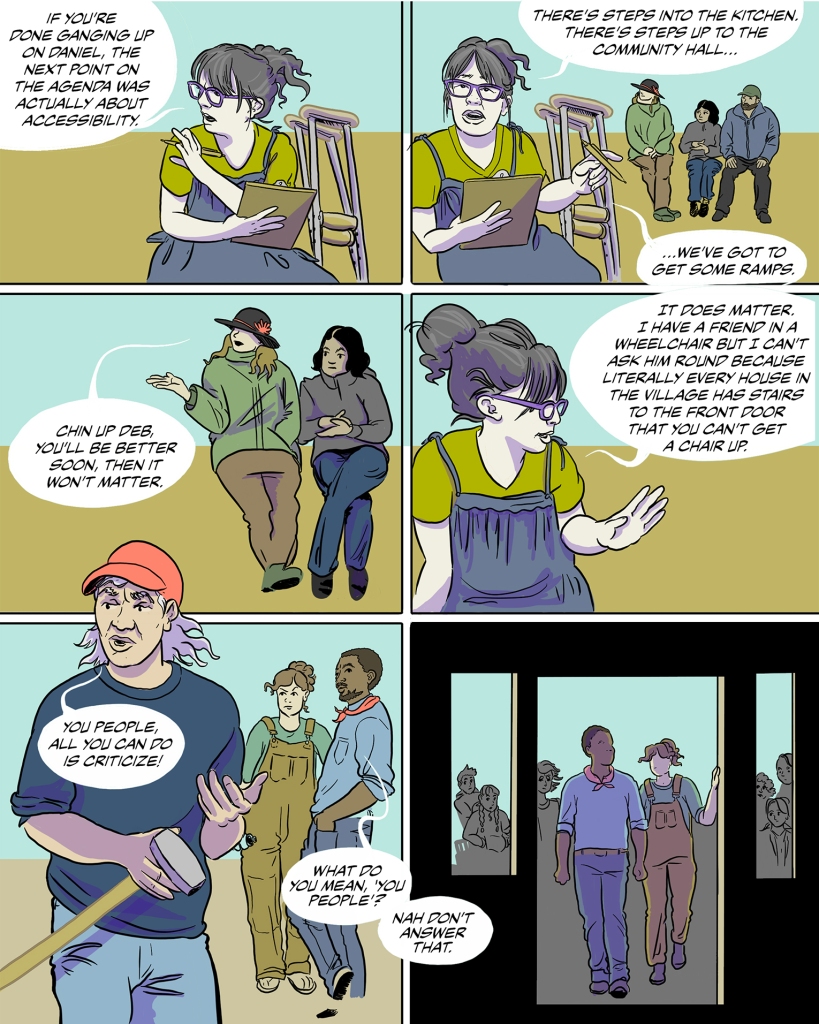
What is it like to live in an eco-community? What are the highlights and the challenges? This short comic explores everyday eco-community life. Based on my experiences of working with eco-communities, in Britain and worldwide over the last 15 years, it captures some of the daily joys and dilemmas of living together ecologically.
Eco-communities are collective and collaborative projects that seek to balance human with environmental needs. They encompass eco-villages, intentional communities, co-housing and low impact developments among others. They share common concerns for minimising environmental impact, maximising use of renewable energies and materials, self-provision (such as food), and seeking to reshape social lives, with an emphasis on mutual aid, sharing of spaces and resources, and an ethics of collectivity.
Eco-communities seek permanent and lasting shifts in the world. Their interventions are no less radical than the demands of the social justice and environmental activism from which many emerge, but their permanency requires then to negotiate, navigate and at times compromise. At times the ecological rationale of eco-communities overrides and erodes the social justice politics that many of them began with.
Eco-communities make visible the politics of individuals, and in so doing the complex politics of everyday social lives and living together. The negotiations required to share personal spaces, other people’s children, the laundry, a neighbours’ musical choices, for example, become writ-large in the success or failure of an eco-community.
The comic also purposefully explores the tensions of who lives in these places, asking questions about diversity, inclusion and belonging. There are often gaps between the imagined, the intent and the realisation of these radical projects. This is not a problem of affordability; indeed many residents are not financially well-off and many projects are explicitly structured to enable low income participation. Rather these projects tend to lack racial or class diversity, and gender and disability are sometimes only explored in limited ways. This happens because the lack of this diversity, while noted and anguished over, is not understood as a structural problem of belonging, identity, racism and social justice. Seemingly subtle assumptions about participation, common values, lifestyle and food choices shape who gets to be part of eco-communities, who feels welcome and who sees space for themselves living there.
We made this comic as a hopeful way to open up some of the conversations about eco-communities – their potentials and also elements that need further reflection.
Jenny Pickerill, University of Sheffield

We hope you enjoy this comic, please do share and use it. This work is shared under the Creative Commons license of Attribution-NonCommercial-ShareAlike CC BY-NC-SA

The words were written by Hugh Goldring (@ooHugh) and the illustrations are by Nicole Burton (@nicolemcomix), both of Petroglyph Studios.
Thanks to the Urban Studies Foundation, who funded the research which bought these ideas together.
If you are interested in the research behind this comic, below is a sample of writings which explore these themes further:
- Eco-homes: People, place and politics.
- Making space for disability in eco-housing and eco-communities.
- Bodies, building and bricks: Women architects and builders in eight eco-communities in Argentina, Britain, Spain, Thailand and USA.
- Eco-communities as insurgent climate urbanism: Radical urban socio-material transformations.
- Confronting privilege: The radical potential of eco-communities for urban climate justice.








Living an eco-friendly life in an eco-community is eco-conscious. Thank you 😊